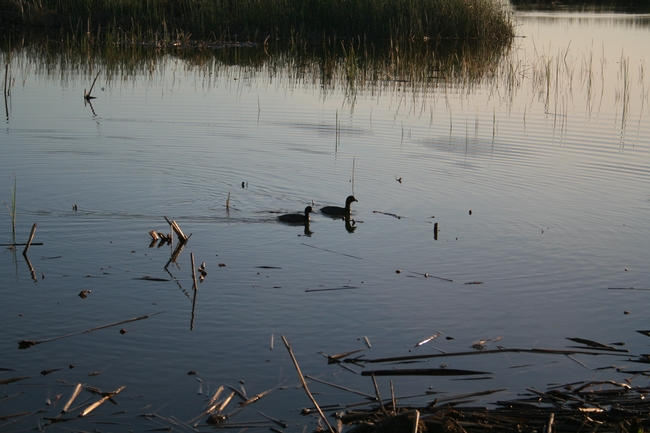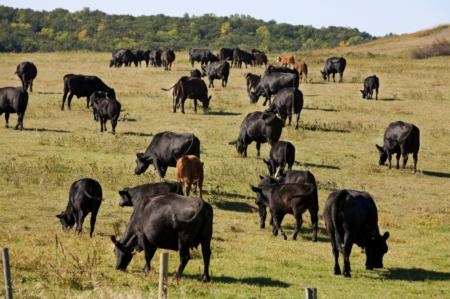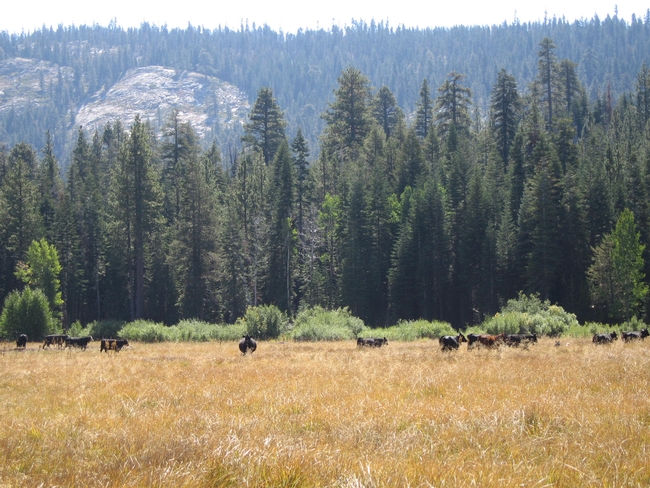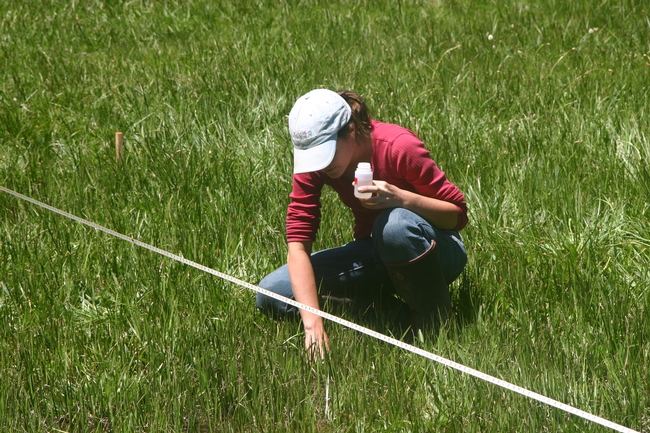Posts Tagged: grazing
Grazing public lands is compatible with recreation, UC scientists say
The media coverage was one of numerous stories that have appeared around the country about the research, including Bloomberg, Cattle Network, Progressive Cattle, Science Daily, AgWeb and the UC Green Blog.
The study was conducted from June to November 2011. Nearly 40 UC Davis researchers, ranchers, U.S. Department of Agriculture Forest Service staff and environmental stakeholders went out by foot and on horseback, hiking across meadows, along campsites, and down ravines to collect 743 water samples from 155 sites across five national forests in northern California.
The scientists found that recreation sites were the cleanest, with the lowest levels of fecal indicator bacteria. They found no significant differences in fecal indicator bacteria between grazing lands and areas without recreation or grazing. Overall, 83 percent of all sample sites and 95 percent of all water samples collected were below U.S. Environmental Protection Agency benchmarks for human health.
Cattle grazing and clean water not mutually exclusive
Cattle grazing and clean water can coexist on national forest lands, according to research by the University of California, Davis.
The study, published June 27 in the journal PLOS ONE, is the most comprehensive examination of water quality on National Forest public grazing lands to date.
“There’s been a lot of concern about public lands and water quality, especially with cattle grazing,” said lead author Leslie Roche, a postdoctoral scholar in the UC Davis Department of Plant Sciences. “We’re able to show that livestock grazing, public recreation and the provisioning of clean water can be compatible goals.”
Roughly 1.8 million livestock graze on national forest lands in the western United States each year, the study said. In California, 500 active grazing allotments support 97,000 livestock across 8 million acres on 17 national forests.
“With an annual recreating population of over 26 million, California’s national forests are at the crossroad of a growing debate about the compatibility of livestock grazing with other activities dependent upon clean, safe water,” the study’s authors write.
“We often hear that livestock production isn’t compatible with environmental goals,” said principal investigator Kenneth Tate, UC Cooperative Extension specialist in the Department of Plant Sciences at UC Davis. “This helps to show that’s not absolutely true. There is no real evidence that we’re creating hot spots of human health risk with livestock grazing in these areas.”
The study was conducted in 2011, during the grazing and recreation season of June through November. Nearly 40 UC Davis researchers, ranchers, U.S. Department of Agriculture Forest Service staff and environmental stakeholders went out by foot and on horseback, hiking across meadows, along campsites, and down ravines to collect 743 water samples from 155 sites across five national forests in northern California.
These areas stretched from Klamath National Forest to Plumas, Tahoe, Stanislaus and Shasta-Trinity national forests. They included key cattle grazing areas, recreational lands and places where neither cattle nor humans tend to wander.
UC Davis researchers analyzed the water samples for microbial and nutrient pollution, including fecal indicator bacteria, fecal coliform, E. coli, nitrogen and phosphorous.
The scientists found that recreation sites were the cleanest, with the lowest levels of fecal indicator bacteria. They found no significant differences in fecal indicator bacteria between grazing lands and areas without recreation or grazing. Overall, 83 percent of all sample sites and 95 percent of all water samples collected were below U.S. Environmental Protection Agency benchmarks for human health.
The study noted that several regional regulatory programs use different water quality standards for fecal bacteria. For instance, most of the study’s sample sites would exceed levels set by a more restrictive standard based on fecal coliform concentrations. However, the U.S. EPA states that E. coli are better indicators of fecal contamination and provide the most accurate assessment of water quality conditions and human health risks.
The study also found that all nutrient concentrations were at or below background levels, and no samples exceeded concentrations of ecological or human health concern.
The study was funded by the USDA Forest Service, Region 5.
The study has been covered by Bloomberg, Cattle Network, Progressive Cattle, Science Daily and AgWeb.
Caltrans to cooperate with UCCE on long-term rangeland practices study
A settlement between Caltrans and the California Farm Bureau Federation, which resulted in CFBF dismissing a lawsuit against Caltrans about the Willits Bypass Project, includes a long-term wetlands study by UC Davis and UC Cooperative Extension researchers, according to Caltrans and farm bureau press releases issued last week.
Caltrans is building a bypass along U.S. Route 101 around the community of Willits. The project will relieve congestion, reduce delays, and improve safety for traffic and pedestrians, Caltrans said. CFBF filed the lawsuit because of concern about how the project would impact farmland in the Little Lake Valley.
"Specifically, Farm Bureau was concerned about the amount of farmland the U.S. Army Corps of Engineers mitigation strategy required to be removed from production in order to mitigate for wetlands affected by the bypass," the CFBF press release said.
According to the terms of the agreement noted in both press releases, Caltrans will cooperate with UC Davis and UCCE to study how grazing management contributes to enhanced wetland function.
The study will look at land owned by the state — where grazing is required — and federally owned land — where grazing is prohibited — and consider how to optimize grazing productivity while achieving the desired wetlands enhancements. The research will provide an opportunity to study how natural resources can be preserved and land utilized for both grazing and wetlands.

UC researchers will study how to optimize grazing productivity while achieving desired wetlands enhancements.
Rangelands could offset tons of carbon emissions
With proper management, already productive California rangeland could single-handedly offset the state's carbon emissions, believe researchers involved in The Marin Carbon Project.
The ongoing effort was covered by the San Rafael/Terra Linda News Pointer in connection with a Bioneers Conference taking place Oct 15-17 at San Rafael’s Marin Center.
The Marin Carbon Project was formed to establish the basis for rangeland soil carbon sequestration. Initiated two years ago, the project involves ranchers and researchers representing UC Berkeley, UC Davis, UC Cooperative Extension, Marin Organic, Marin Agricultural Land Trust, Marin Resource Conservation District, the USDA Natural Resources Conservation Service, Nicasio Native Grass Ranch, the Marin County Agriculture Commissioner and the Environmental Defense Fund.
Soil surveys to establish pre-existing levels of carbon in Marin rangeland soils have been completed. This baseline data will allow the accurate assessment of how much carbon improved management practices sequester over time.
For example, project co-founder John Wick told reporter Anna McCarthy that composting wet dairy manure with greenwaste and spreading it on rangelands increases rangeland production and reduces the risk of pathogen runoff into waterways. The practice also "turns the land into a carbon sucking machine," McCarthy wrote.
“It works,” Wick was quoted. “And it works at such a rate, it’s phenomenal.”
A year after adding a half-inch dusting of compost to his rangelands, Wick said the soil yielded 10 tons of carbon per hectare (10,000 square meters).
“That rate, applied on one-third of California’s rangeland, would offset all of California’s emissions every year,” Wick told the reporter.

The Marin Carbon Project seeks to document carbon sequestration in rangeland.
Scientists to minimize impact of High Sierra grazing
University of California, U.S. Forest Service and other agencies will work together to understand the impact of cattle grazing in the High Sierra and look for solutions to water quality problems, according to an article in the Sonora Union Democrat.UC Davis Cooperative Extension watershed specialist Ken Tate and interim director of the Western Institute for Food Safety and Security at UC Davis Rob Atwill will design and conduct the study. The first samples have already been collected.
In the story, writer Ashley Archibald reported that the scientists are seeking to fix problems, not just document them.
“It’s good to focus on what are the practices that can move us forward so everyone can enjoy the national forest since it has a multiple use mandate and is a resource for the public, and the public is pretty diverse," Atwill was quoted.
Scott Oneto, the director and farm advisor for the UC Cooperative Extension in Calaveras and Tuolumne counties, said the scientists are still looking for input on how to build a comprehensive study.
The California Farm Bureau Federation's weekly publication AgAlert
also weighed in on the new study. The paper said the scientists held a briefing for ranchers in Sonora where they explained their desire to acquire data to demonstrate the relationship between grazing on public lands and water quality requirements.
The article - written by AgAlert editor Kate Campbell - noted that the scientists will take multiple water samples from 48 different sites in the High Sierra over the next several months, with preliminary results available by the end of this year. Sites will include areas used for grazing and recreation.




